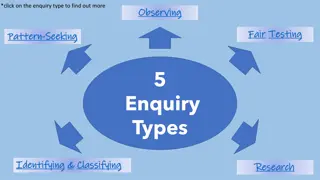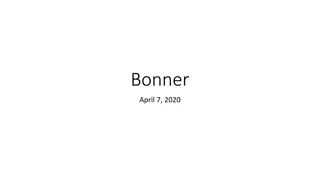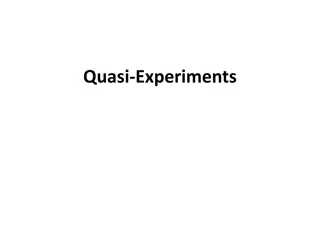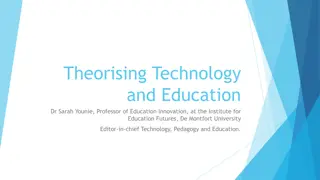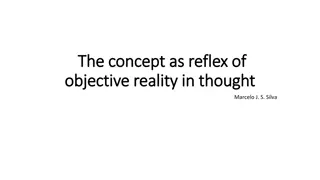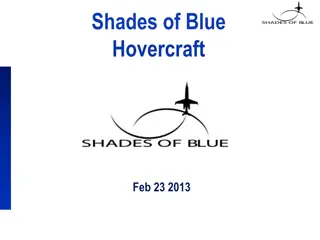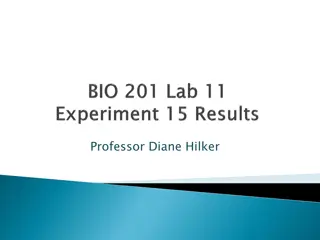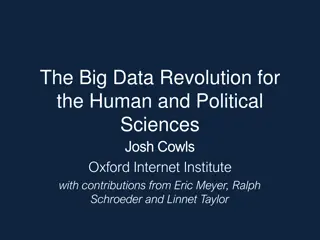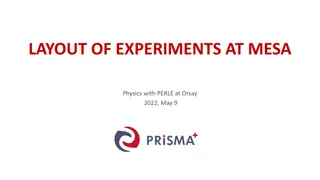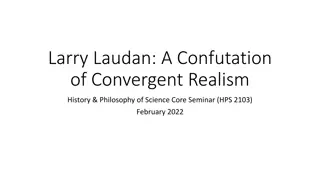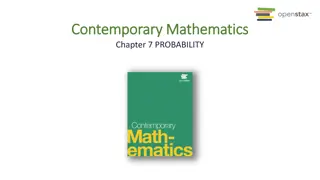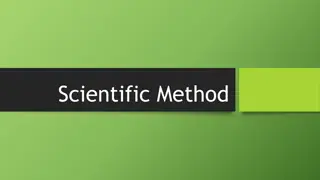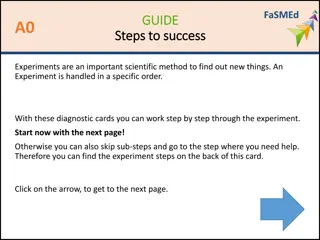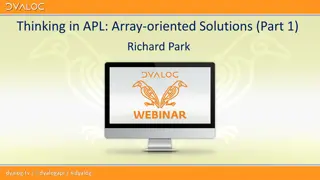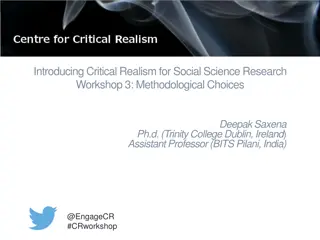The Epistemological Problem of Thought Experiments in Science
Explore the epistemological challenge of how thought experiments lead to new scientific knowledge, illustrated through examples like Maxwell's Demon. Delve into the clash between thermodynamics and molecular kinetic theory, questioning the applicability of our macroscopic experiences at the microscopic scale.
Download Presentation

Please find below an Image/Link to download the presentation.
The content on the website is provided AS IS for your information and personal use only. It may not be sold, licensed, or shared on other websites without obtaining consent from the author.If you encounter any issues during the download, it is possible that the publisher has removed the file from their server.
You are allowed to download the files provided on this website for personal or commercial use, subject to the condition that they are used lawfully. All files are the property of their respective owners.
The content on the website is provided AS IS for your information and personal use only. It may not be sold, licensed, or shared on other websites without obtaining consent from the author.
E N D
Presentation Transcript
Thought Experiments in Science John D. Norton Department of history and Philosophy of Science University of Pittsburgh Pittsburgh Summer Program 6 Center for Philosophy of Science, University of Pittsburgh July 11-15, 2022 This lecture: ???
http://www.pitt.edu/ ~jdnorton/lectures/ CPS_summer_2022 /CPS_summer_2022. html 2
Please Think About this Problem The epistemological problem of thought experiments in science: How can merely experimenting in thought provide new knowledge of the natural world? Replacement for the superconducting supercollider. www.thought-experiment-jokes.com 3
Three Thought Experiments 1. Maxwell s Demon 2. The Rotating Disk 3. The Dome 4
1. Maxwells Demon 5
Thermodynamics versus the molecular kinetic theory. Heat ALWAYS passes from hot to cold only. Unconfined gases ALWAYS expand. 6
Thermodynamics versus the molecular kinetic theory. A molecular gas can spontaneously recompress. The microscopic physics of molecular gases is not directed in time. 7
Theory of Heat, 1871, first ed. Also Letter to Tait, 1867; Rayleigh 1871 8
Theory of Heat 9 Better scan from 1872, 2nd ed.
Maxwells Proposal He will thus, without expenditure of work, raise the temperature of B air initially at uniform temperature and lower that of A, in contradiction to the second law of thermodynamics. 10
Maxwells Moral: The Demon Wins This is only one of the instances in which conclusions which we have drawn from our experience of bodies consisting of an immense number of molecules may be found not to be applicable to the more delicate observations and experiments which we may suppose made by one who can perceive and handle the individual molecules which we deal with only in large masses. The demon illustrates that Second Law would fail if we could manipulate individual molecules. No compulsion to exorcise the demon to protect the Second Law. In dealing with masses of matter, while we do not perceive the individual molecules, we are compelled to adopt what I have described as the statistical method of calculation, and to abandon the strict dynamical method, in which we follow every motion by the calculus. . Nanotechnology has not yet overturned the Second Law. Theory of Heat. 11
2. The Rotating Disk 12
Einsteins Discovery of Relativity Theory 1905 Apply the principle of relativity to inertialmotion. Special relativity ??? 1907, 1908, 1909, 1910, 1911, 1912, 1913, 1914, 1915. Extend the principle of relativity to acceleratedmotion. rotation Rectilinear acceleration Gravity slows clocks, slows and bends light. 13
Rotating Disk 1912 > xdiameter circumference = x diameter circumference Length of radial rods unaffected by motion. measured by laying out moving, contracted rods end to end. measured by laying out rods end to end. Geometry found on a rotating disk is non-Euclidean. 14
3. The Dome An Indeterminstic Newtonian System 15
The Arrangement A unit mass sits at the apex of a dome over which it can slide frictionless. The dome is symmetrical about the origin r=0 of radial coordinates inscribed on its surface. Its shape is given by the (negative) height function h(r) = (2/3g)r3/2. The mass experiences an outward directed force field F = (d/dr) potential energy = (d/dr) gh = r1/2. The motion of the mass is governed by Newton s F=ma : d2r/dt2 = r1/2. 16
Possible motions: None r(t) = 0 solves Newton s equation of motion since d2r/dt2 = d2(0)/dt2 = 0 = r1/2. 17
Possible motions: Spontaneous Acceleration The mass remains at rest until some arbitrary time T, whereupon it accelerates in some arbitrary direction. r(t) = 0, for t T and r(t) = (1/144)(t T)4, for t T solves Newton s equation of motion d2r/dt2 = r1/2. For t T, d2r/dt2 = d2(0)/dt2 = 0 = r1/2. For t T d2r/dt2= (d2 /dt2) (1/144)(t T)4 = 4 x 3 x (1/144) (t T)2 = (1/12) (t T)2 = [(1/144)(t T)4]1/2 = r 1/2 18
The computation again For t T, d2r/dt2 = d2(0)/dt2 = 0 = r1/2. For t T d2r/dt2= (d2 /dt2) (1/144)(t T)4 = 4 x 3 x (1/144) (t T)2 = (1/12) (t T)2 = [(1/144)(t T)4]1/2 = r 1/2 19
The Dome without Calculus Imagine the mass projected from the edge. Close 20
The Dome without Calculus Imagine the mass projected from the edge. Closer 21
The Dome without Calculus Imagine the mass projected from the edge. BINGO! Now consider the time reversal of this process. Spontaneous motion! BUT there is a loophole. Spontaneous motion fails for a hemispherical dome. How can the thought experiment fail in that case? 22
How do these thought experiments inform us? 23
Epistemologies of Thought Experiments Platonism, Intuitionism Brown Laws of nature reside in a Platonic world. We perceive the laws directly in the right sort of thought experiment. Thought experiments gain epistemic power through their mimicry of real experiments. Experimentalism Sorensen Thought experiments reveal lacunae in our conceptual systems and show us how to reconfigure them. Constructivism Kuhn, Gendler The mind has the power to simulate the world through visualization. Visualization and Simulation Arthur Mental Models Nersessian, Palmieri Thought experiments are the manipulation of mental models discussed in recent cognitive science. Arguments Norton Thought experiments are merely disguised, picturesque argumentation. 24
The Argument View 25
Two Versions Thought experiments are arguments that (i) posit hypotheticals or counterfactuals ( thought ); (ii) invoke irrelevant particulars ( experiment ). Context of Justification Context of Discovery The reconstruction thesis: All thought experiments can be reconstructed as arguments based on tacit or explicit assumptions. Belief in the outcome is justified only in so far as the reconstructed argument is cogent. The execution thesis: The actual carrying out of a thought experiment is the execution of an argument, even if in disguised form. 26
Einsteins Rotating Disk Thought Experiment Reconstructed (D1) In Euclidean geometry, the measured circumference of a disk is times its diameter. (Premise) (D2) The geometry of a non-rotating disk is Euclidean. (Premise) (D3) The motion of a radial element on a rotating disk is perpendicular to its length, so that (according to special relativity) the length is unaltered. (Premise) (D4) The motion of a circumferential element on a rotating disk is along its length, so that (according to special relativity) the length is contracted. (Premise) (D5) Therefore the measured circumference of a rotating disk is more than times the measured diameter. (From D2, D3, D4) (D6) Therefore the geometry of a rotating disk is not Euclidean. (From D1, D5) 28
For the reconstruction thesis 1. No magic epistemology 2. No counterexamples 29
Results of a good thought experiment come from somewhere Ordinary or Extraordinary A thought experiment is short narrative that reports no novel empirical facts. Result comes from reconfiguring what we already know. Result comes from Epistemic magic No viable position in between. 31
Results of a good thought experiment come from somewhere Ordinary or Extraordinary Result comes from reconfiguring what we already know. Result comes from Epistemic magic 32
Results of a good thought experiment come from somewhere Ordinary or or Extraordinary Extraordinary Result comes from reconfiguring what we already know. Result comes from Result comes from Epistemic magic Epistemic magic Why choose magic when the prosaic suffices? 33
How ordinary reconfiguring works. Reconfigure by means that preserve truth. deductive argument What we already know. or preserve its likelihood. inductive argument 34
No counterexamplesin 30 years of efforts to find them. The open challenge: find a counterexample. Why it is hard to do: Thought experiments are refined instruments communicated fully in a short narrative. Logic, ordinary modes of reasoning, are expansive and elastic. Umm , I m not worried. 36
For the execution thesis 1. Reading the narrative 2. Suspicious powers 37
1. The narrative The narrative of a typical thought experiments in science lays out an argument, step by step, to the conclusion sought. We read the narrative critically, proceeding from step to step, ensuring that we agree with each step. The actual carrying out of a thought experiment is the execution of an argument, even if in disguised form. The execution thesis 38
2. Suspicious powers Epistemic reach of a thought experiment. Epistemic reach of a picturesque argument. = How can this happen if the execution of a thought experiment implements some other power of or process in the mind? 40
You have always wanted to be a sailor. You hate broccoli. I have always wanted to be a sailor. I hate broccoli. My Year Book 41
The Reliablity Challenge 42
Thought experiments can err. thought we must be able to distinguish the epistemically successful from the unsuccessful thought experiment. IF THEN experimenting is to be a reliable instrument, Thought experiment anti thought experiment pairs. The challenge: The argument view can distinguish good from bad: How do other accounts distinguish? A good thought experiment is a good argument. A bad thought experiment is a bad argument. 43
Thought Experiment Anti Thought Experiment Pairs 44
Einsteins rotating disk (three versions) C < D Moving rings contracted circumferentially but not radially Petzold (to Einstein, July 26, 1919) C = D Figures at an instant traced onto non-rotating tracing paper. Varicak 1911 (after a method by Ehrenfest) C > D Tangential rods contracted Radial rods uncontracted Einstein 1912 45
The Helicopter: the Thought Experiment What is the lift generated by an infinite, non- rotating rotor? Double rotor size. Halve rotor speed. Rotor lift stays the same (at L). Power consumed is halved. In the limit of infinitely many doublings, an infinite, non-rotating rotor generates lift L and consumes no power. That must be how angels work. Wide wing spans. --Jeremy Butterfield 46
The Helicopter: the Anti-Thought Experiment What is the lift generated by an infinite, non- rotating rotor? A finite, non- rotating rotor generates no lift. Double rotor size. Rotor still generates no lift. In the limit of infinitely many doublings, an infinite, non-rotating rotor generates no lift. 47
Thought experiment Space is finite. Anti Thought experiment Space is infinite. Aristotle, On the Heavens, Bk 1, Ch. 5, 272a8-21 Archytas, reported by Simplicius could I not stretch my hand or stick outside... In an infinite, rotating universe, when does the infinite radius ACE first contact BB? 48
Car in the garage Thought experiment. A car approaches a garage at 86%c. The car is contracted 50%. Car fits. Anti thought experiment. The garage approaches the car at 86%c. The garage is contracted 50%. Car does not fit. They are the same case, viewed in two different frames of reference. 49
Variation: Rod in a slot More: Newton s bucket vs Mach s bucket. 50


